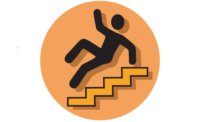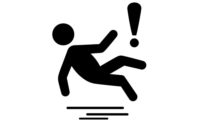Preventing falls on the same level
Train your employees in 5S programs

Falls, slips and trips account for 15 percent of all accidental deaths per year, second only to motor vehicles as a cause of fatalities, according to the Bureau of Labor Statistics. Falls, slips and trips also account for 25 percent of all reported injury claims and more than 95 million lost work days per year, according to the BLS.
Of interest, the incidence of lost-time falls occurring on the same level (17.45 per 10,000 workers) was triple falls to a lower level (5.4 per 10,000) in 2013. One training strategy to reduce falls on the same level is to train your workforce in the Japanese 5S methodology.
Among numerous other objectives, 5S aims to eliminate things like over-production, unnecessary transportation, over-processing and wasted employee motions and movement. The rush to produce, unnecessary material handling and wasted motions and movement can all result in slips, trips and falls in your facility.
Before you roll
Before rolling out a 5S initiative and training your employees, first senior leadership at your facility must buy into the benefits of 5S. 5S is a sweeping, culture-changing organizational value based on five “pillars” – 1) seiri, or sort; 2) seiton, or set in order or systematize; 3) seiso, or sweep or shine; 4) seiketsu, or standardize; and 5) shitsuke, or self-discipline or sustain.
Once you’ve obtained top management support and involvement in 5S, it’s important early on in training your workers not to refer to 5S as a “program.” Programs have beginnings and endings. Employees watch many programs come and go. They can be perceived as “flavors of the month” or fads. Employees can adopt the passive attitude, “This too shall pass.”
More than housekeeping
5S also should not be presented as simply a housekeeping effort on steroids. Your training audience for 5S is not simply janitors and cleaning crews. Another important point: 5S cannot be taught in a single classroom training session. It is a culture-changing process with many components and consequences. Among the outcomes: less clutter, less trash, less movement, better organization of tools and materials on the shop floor – all leading to fewer slips, trips and falls.
Start your 5S training by targeting one department, one work process, one location in your facility. Form a multi-disciplinary implementation team. The team will need training in how to conduct a needs assessment for the pilot target; how to evaluate the work environment, work conditions and work flow; and how to observe current work behaviors.
The pilot team’s assessment will determine what kind, and how much, employee education is needed. Your training should be complemented by 5S-related signage, posters, message boards, newsletters, internal emails, and social media. Training includes setting goals for 5S improvements (waste reduction, defects reduction, reduction in slip, trip and fall injuries, and more). Employees must learn how to track progress and give feedback toward attaining those goals through visual communications – scoreboards, messaging, calendars, etc. And for your training to stick, you need to recognize and reward 5S achievements.
Ownership is key
The underlying objective of your 5S training is ownership -- everyone in your organization must own 5S. Through education and training, they must come to believe housekeeping; preventing slips, trips and falls; waste reduction; and optimal productivity are within their control – and not the responsibility of someone else. Teach your employees to look at their work space as their homes.
Your employees must be sold that 5S daily practices are not drudgery, but in the end will save them time (less waiting around); wasted movement (less “searching around for something somewhere”); and reduce slips, trips and fall injuries – or worse. Your training must be able to answer an employee’s bottom line question about 5S (or any safety initiative): “What’s in it for me?”
Take it in steps
One way to approach 5S training is to devote modules to the five attributes. In Step 1 (Sort), employees are trained on the criteria for removing – by red-tagging – all tools, materials, equipment, etc. not needed to get a job done.
Workers in training sessions need to conduct personal needs assessments. What do I need to do my job? Where should I locate each item I need? How many of each item do I really need?
Step-one training should emphasize the need for daily cleaning to become a habit. Ten or 15 minutes should be set aside daily for sweep and shine activity. Teach employees to use this daily cleaning routine to inspect the work space and equipment for defects.
Employees and 5S teams should be trained to conduct root cause analyses to uncover why slips, trips and falls are occurring, and how to correct problems. A log should record the location of incidents, circumstances surrounding the incident, who is responsible for taking corrective action, when a solution will be implemented, and exactly how the solution will be implemented.
In order for the first three steps of 5S to be regularly repeated and become habit, you’ll need to train employees and supervisors in routines and standard operating procedures. Training also covers cleaning schedules that are standardized using 5S owner check sheets. Training emphasizes the importance of single-point lesson plans or instructions that are posted and visibly prominent to document and communicate 5S procedures for steps 1, 2 and 3 for each work station or work space. Training also emphasizes accountability. Every employee is responsible for following these lessons and carrying out these instructions.
A culture of discipline
Discipline – an indispensable part of 5S success – takes root during training. Message boards, storytelling boards, scoreboards, signs, banners and other visuals are critical to sustain self-discipline. Your employees must be aware of – and recognized for -- 5S accomplishments such as targeted decreases in defect rates and injury and illness rates, and improvements in inventory management, lead times, delivery times and productivity measures.
Throughout your training, remind your employees that 5S programs are indispensable to safety cultures – and to reducing the number of slips, trips and falls. Show employees that every element of 5S has safety implications. Sort removes unnecessary items, clutter, and waste from work spaces, reducing the chances of slips, trips, and falls. Set keeps important tools and materials nearby, reducing shortcuts and unnecessary movements. Shine keeps work spaces free from contaminants. Standardize brings consistency and reliability to how work is organized and flows, reducing error traps and at-risk behavior. Sustain creates big picture situational awareness – that workplace efficiency and safety are all long-term processes that hinge on individual ownership, accountability, and responsibility. Bottom line, your 5S training must result in your employees internalizing and personalizing the principles of Sort, Set, Shine, Standardize, and Sustain.
Looking for a reprint of this article?
From high-res PDFs to custom plaques, order your copy today!








